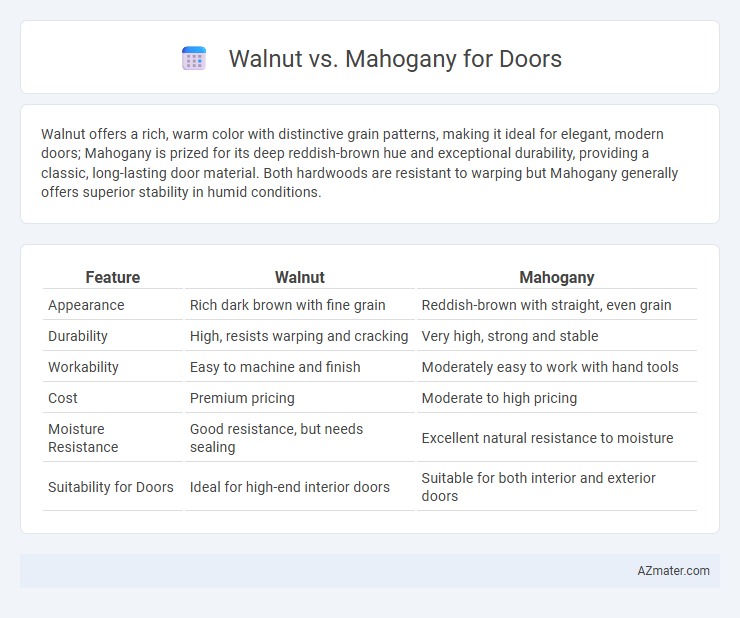Walnut offers a rich, warm color with distinctive grain patterns, making it ideal for elegant, modern doors; Mahogany is prized for its deep reddish-brown hue and exceptional durability, providing a classic, long-lasting door material. Both hardwoods are resistant to warping but Mahogany generally offers superior stability in humid conditions.
Table of Comparison
| Feature | Walnut | Mahogany |
|---|---|---|
| Appearance | Rich dark brown with fine grain | Reddish-brown with straight, even grain |
| Durability | High, resists warping and cracking | Very high, strong and stable |
| Workability | Easy to machine and finish | Moderately easy to work with hand tools |
| Cost | Premium pricing | Moderate to high pricing |
| Moisture Resistance | Good resistance, but needs sealing | Excellent natural resistance to moisture |
| Suitability for Doors | Ideal for high-end interior doors | Suitable for both interior and exterior doors |
Introduction to Walnut and Mahogany Doors
Walnut doors offer rich, warm tones with a fine, straight grain that enhances elegance and durability, making them ideal for high-end interior use. Mahogany doors are prized for their deep reddish-brown color, exceptional hardness, and resistance to rot, providing long-lasting beauty and strength for both interior and exterior applications. Both wood types deliver superior performance and timeless appeal, but walnut is favored for its refined aesthetics while mahogany is chosen for robust structural qualities.
Appearance and Grain Patterns
Walnut doors feature rich, dark brown hues with occasional purplish undertones, exhibiting straight to wavy grain patterns that add depth and elegance. Mahogany doors showcase a reddish-brown color that deepens over time, with consistently straight, fine, and interlocking grain patterns contributing to a smooth and luxurious finish. Both woods offer striking appearances, but walnut provides more variation in grain, while mahogany emphasizes uniformity and classic warmth.
Durability and Longevity Comparison
Walnut offers moderate durability with a Janka hardness rating of around 1,010, making it resistant to dents and scratches, while mahogany boasts a higher Janka hardness rating of approximately 1,220, providing superior strength and resistance to wear. Mahogany's natural oils contribute to its excellent resistance against moisture, decay, and insect damage, enhancing its longevity in various environmental conditions. Doors crafted from mahogany typically last longer than walnut due to mahogany's enhanced durability, making it a preferred choice for high-traffic and exterior applications.
Resistance to Moisture and Warping
Walnut offers moderate resistance to moisture and warping, making it suitable for interior doors in controlled environments but less ideal for high-humidity areas. Mahogany exhibits superior moisture resistance and dimensional stability, effectively reducing the risk of warping and swelling in damp conditions. Its dense grain structure and natural oils enhance durability, making mahogany a preferred choice for doors exposed to fluctuating humidity.
Maintenance Requirements
Walnut doors require moderate maintenance, benefiting from periodic polishing and protection from excessive moisture to preserve their rich grain and prevent warping. Mahogany doors demand less frequent upkeep due to their natural resistance to rot and insect damage, but regular sealing and occasional refinishing are essential to maintain their deep reddish-brown hue and durability. Proper climate control and scheduled care protocols significantly extend the lifespan and aesthetic appeal of both walnut and mahogany wooden doors.
Cost Differences: Walnut vs Mahogany
Walnut doors typically cost between $30 to $40 per square foot, while mahogany doors are priced higher, ranging from $50 to $70 per square foot due to mahogany's greater durability and rich appearance. The price variation is influenced by wood availability, with walnut being more abundant and easier to source, resulting in lower costs. For budget-conscious buyers seeking premium quality, walnut offers a cost-effective option without compromising on aesthetics, whereas mahogany commands a premium price for its superior hardness and resistance to moisture.
Environmental Sustainability and Sourcing
Walnut doors originate from trees predominantly found in North America and Europe, with sustainable sourcing efforts including certified forestry programs promoting reforestation and responsible harvest. Mahogany, often sourced from tropical rainforests in Central and South America, faces challenges such as illegal logging and deforestation, raising concerns about its environmental sustainability despite certification schemes like FSC aiming to improve practices. Choosing walnut for doors tends to offer a lower environmental impact due to more regulated and transparent supply chains, whereas mahogany requires careful verification to ensure ethically and sustainably sourced material.
Ease of Customization and Finishing
Walnut offers superior ease of customization due to its fine, straight grain and uniform texture, allowing for intricate carvings and detailed joinery with minimal effort. Mahogany, while also workable, has a coarser grain that may require more preparation for intricate detailing but excels in taking stains and finishes evenly to produce a rich, deep coloration. Both woods respond well to various finishing techniques, though walnut's natural smoothness enhances the final aesthetic with less sanding and preparation.
Best Applications for Each Wood Type
Walnut excels in interior doors where rich color and fine grain enhance aesthetic appeal, making it ideal for luxury residential projects and custom cabinetry. Mahogany's superior durability and resistance to moisture make it perfect for exterior doors and high-traffic areas, ensuring long-lasting performance in varied climates. Both woods offer distinct advantages, with walnut favored for decorative applications and mahogany preferred for structural and weather-exposed uses.
Final Verdict: Which Wood is Better for Your Door?
Walnut offers a rich, dark finish with exceptional durability, making it ideal for doors requiring a luxurious appearance and long-lasting strength. Mahogany provides excellent resistance to moisture and decay, making it suitable for exterior doors exposed to varying weather conditions. Choose walnut for elegant interior doors prioritizing aesthetics, and mahogany for durable, weather-resistant exterior doors.

Infographic: Walnut vs Mahogany for Door
 azmater.com
azmater.com